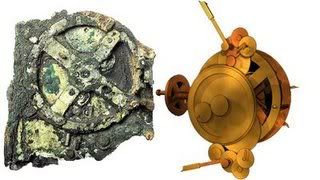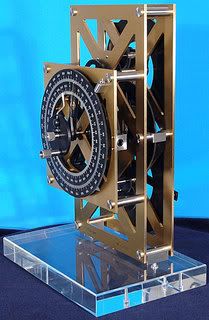Price believed that the Mechanism was an ancient “computer,” which could be used to calculate astronomical events in the near or distant future: the next full moon, for example. He realized that the inscriptions on the large dial were calendrical markings indicating months, days, and the signs of the zodiac, and postulated that there must have been pointers, now missing, that represented the sun and the moon and possibly the planets, and that these pointers moved around the dial, indicating the position of the heavenly bodies at different times.Price set about proving these theories, basing his deductions on the fundamental properties of gearing. Gears work by transmitting power through rotational motion, and by realizing mathematical relationships between toothed gear wheels. The Mechanism concentrates on the latter aspect. Price seems to have assumed that the largest gear in the artifact, which is clearly visible in Fragment A, was tied to the movement of the sun—one rotation equalled one solar year. If another gear, representing the moon, was driven by the solar gear, then the ratio of wheels in this gear train must have been designed to match the Greeks’ idea of the moon’s movements. By counting the number of teeth in each gear, you could calculate the gear ratios, and, by comparing those ratios to astronomical cycles, you can figure out which gears represented which movements.

I did post on this a while back, but this New Yorker article is delicious in its detail and description.
Update 8/8/08:
A commenter on this thread has linked to the Dutch scientist/inventor/extraordinary woman who has created the "ESSENCE OF THE ANTIKYTHERA MECHANISM".

More on Tatjana van Vark.
14 comments:
If only there were a backup of the library at Alexandria.
Of course, all the little fragments can be reassembled -- God bless Wikipedia.
These finds are so fun. The ancients weren't stupid and in fact, if a child from that era were to be raised in our times, I doubt there would be any difference.
They had less resources, not less brains.
Cool. Thanks for the New Yorker link, ellroon.
The term "computer" is ambiguous enough to encompass a lot of calculating mechanisms of various ages in common parlance, but today the term is used mostly to identify a device that, at a minimum, can be programmed to accomplish different purposes. The Antikythera Mechanism has several built-in capabilities, but I've not seen any indication that it is programmable.
For that, history had to wait for Mr. Babbage and Ada, Countess Lovelace. Babbage's analytical engine, a sort of mechanical stored-program computer in many ways similar to later electronic computers, was never completed, but Ada apparently contrived a program for it, arguably the first computer program ever (though that is debated).
Still, the Antikythera Mechanism is utterly astonishing for its age. No one I know... and I know some awfully bright people... could create such a thing from whole cloth (so to speak) today.
Afterthought: though I do not know her (and hence my statement above still stands), I'll bet Tatjana van Vark could create such a device. Whether or not she could... and I'd bet a great deal that she could, and just might someday... I know you'll find her web site fascinating.
Was it you who referenced her site before?... Think I've seen it, just as confusing as ever.
It must be lonely to be a genius. I hope she has a good support structure...
"I hope she has a good support structure..." - ellroon
ellroon, she's Dutch; that speaks volumes, both to her eccentricity (she would surely fault me for using a technical mechanical term in such a metaphorical way) and to her ability to pursue anything she is talented at and still manage a livelihood. The quirkiness of her web site reminds me of the Dutch people I know: assertive, odd by American standards, sometimes argumentative but mostly in a good-natured way.
Yes, I linked Tatjana's site a couple years ago, and you can count me as one of her admirers. I don't know how she earns her living, but I suspect a machinist/inventor of that caliber need never look for work in a society like that of Netherlands. I love the quote on her home page, about how her site should be experienced:
----------
Verbalisations involve personal semantic reactions, yours and mine.
Verbalisations tend to exclude reality.
Just look, maintaining internal silence, until the meaning of my work becomes clear.
Then share my lifelong joy in the mystery Reality with its surprises, limitations and instabilities.
----------
'Just look, maintaining internal silence, until the meaning of my work becomes clear.
Then share my lifelong joy in the mystery Reality with its surprises, limitations and instabilities.'
That is truly beautiful. Thanks.
http://www.tatjavanvark.nl/antikythera/
GO!
She did it!!!!!!!!!!!!!!
Thanks for the link, Anon.
Please go to this website again for an addition to the Antikythera mechanism! http://www.tatjavanvark.nl/antikythera/index.html
Fun! Thanks!
I suggest you visit Tatjana's website again. She has added a four year cycle dial as described in Nature 454 (2008) p. 614-617. See http://www.tatjavanvark.nl/antikythera/ and http://www.nature.com/nature/journal/v454/n7204/pdf/nature07130.pdf.
Regards, Yolande
Thanks Yolande! Her work (and apparently with your assistance?) is exquisite and beautiful.
I will update my post to include Tatjana's site and a picture of her work.
Appreciate the link.
Post a Comment